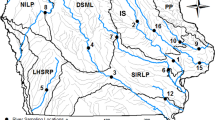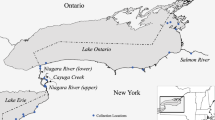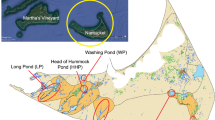Abstract
Mercury (Hg) is a global contaminant of aquatic food chains. Aquatic birds, such as the osprey (Pandion haliaetus), with migratory populations breeding in Canada and the northern United States and wintering in the Central and South America, can be exposed to mercury on both the breeding and wintering ranges. We examined Hg levels in 14 fish taxa from 24 osprey wintering sites identified from satellite telemetry. Our main goal was to determine whether fish species that feature in the diet of overwintering and resident fish-eating birds reached toxicity thresholds for Hg. Mean Hg levels in fish whole carcasses ranged from a high of 0.18 µg g−1 (wet weight) in Scomberomorus sierra to a low of 0.009 µg g−1 in Catostomidae. Average Hg levels were within published toxicity threshold values in forage fish for only two sites in Mexico (Puerto Vallarta and San Blas Estuary), and all were marine species, such as mackerel (Scomberomorus sierra), sea catfish (Ariopus spp.), and sardinas species (Centropomus spp.). Except for one sample from Nicaragua, sea catfish from Puerto Morazan, none of the fish from sites in Central America had Hg levels which exceeded the thresholds. Nonmetric multidimensional scaling revealed geographical differences in Hg levels with significant pairwise differences between sites along the Pacific Ocean (Mexico) versus the Bay of Campeche, partly due to differences in species composition of sampled fish (and species distributions). Hg increased with trophic level, as assessed by nitrogen stable isotope ratios (δ15N but not δ13C), in freshwater and marine, but not estuarine, environments. Hg concentrations in forage fish do not account for the elevated Hg reported for many osprey populations on the breeding grounds, thus primary sources of contamination appear to be in the north.






Similar content being viewed by others
References
Anderson DW, Suchanek TH, Eagles-Smith CA, Cahill TM Jr (2008) Mercury residues and productivity in Osprey and grebes from a mine-dominated ecosystem. Ecol Appl 18:227–238
Bank MS, Chesney E, Shine JP, Waage A, Senn DB (2007) Mercury bioaccumulation and trophic transfer in sympatric snapper species from the Gulf of Mexico. Ecol Appl 17:2100–2110
Braune BM, Gaston AJ, Elliott KH, Provencher JF, Woo KJ, Chambellant M, Ferguson SH, Letcher RJ (2014) Organohalogen contaminants and total mercury in forage fish preyed upon by thick-billed murres in northern Hudson Bay. Mar Pollut Bull 78:258–266
Burnham KP, Anderson DR (2002) Model selection and multimodel inference: a practical information-theoretic approach, 2nd edn. Springer, New York
Choy ES, Gauthier M, Mallory ML, Smol JP, Douglas MSV, Lean D, Blais JM (2010) An isotopic investigation of mercury accumulation in terrestrial food webs adjacent to an Arctic seabird colony. Sci Total Environ 408:1858–1867
Clarke KR, Gorley RN (2006) Primer v5: user manual/tutorial. Primer-E, Plymouth
Davis JA, Greenfield BK, Ichikawa G, Stephenson M (2008) Mercury in sport fish from the Sacramento–San Joaquin Delta region, California, USA. Sci Tot Environ 391(1):66–75
Depew DC, Basu N, Burgess NM, Campbell LM, Evers DC, Grasman KA, Scheuhammer AM (2012) Derivation of screening benchmarks for dietary methylmercury exposure for the common loon (Gavia immer): rationale for use in ecological risk assessment. Environ Toxicol Chem 31:2399–2407
DesGranges JL, Rodrigue J, Tardif B, Laperle M (1998) Mercury accumulation and biomagnification in ospreys (Pandion haliaetus) in the James Bay and Hudson Bay regions of Quebec. Arch Environ Contam Toxicol 35:330–341
Dietz R, Sonne C, Basu N, Braune B, O’Hara T, Letcher RJ, Scheuhammer T, Andersen M, Andreasen C, Andriashek D, Asmund G, Aubail A, Baagoe H, Born EW, Chan HM, Dercocher AE, Grandjean P, Knott K, Kirkegaard M, Krev A, Lunn N, Messier F, Obbard M, Olsen MT, Ostertag S, Peacock E, Renzoni A, Riget FF, Utne Skaare J, Stern G, Stirling I, Taylor M, Wiig I, Wilson S, Aars J (2013) What are the toxicological effects of mercury in Arctic biota? Sci Tot Environ 443:775–790
Eagles-Smith CA, Ackerman JT, De La Cruz SE, Takekawa JY (2009) Mercury bioaccumulation and risk to three waterbird foraging guilds is influenced by foraging ecology and breeding stage. Environ Pollut 157:1993–2002
Elliott KH, Davis M, Elliott JE (2014) Equations for lipid normalization of carbon stable isotope ratios in aquatic bird eggs. PLoS One 9:e83597
Elliott JE, Levac J, Guigueno MF, Shaw DP, Wayland M, Morrissey CA, Elliott KH (2012) Factors influencing legacy pollutant accumulation in alpine osprey: biology, topography, or melting glaciers? Environ Sci Technol 46:9681–9689
Elliott JE, Machmer MM, Henny CJ, Wilson LK, Norstrom RJ (1998) Contaminants in ospreys from the Pacific Northwest: I. Trends and patterns in polychlorinated dibenzo-p-dioxins and-dibenzofurans in eggs and plasma. Arch Environ Contam Toxicol 35:620–631
Elliott JE, Machmer MM, Wilson LK, Henny CJ (2000) Contaminants in ospreys from the Pacific Northwest: II. Organochlorine pesticides, polychlorinated biphenyls, and mercury, 1991–1997. Arch Environ Contam Toxicol 38:93–106
Elliott JE, Morrissey CA, Henny CJ, Ruelas Inzunza E, Shaw P (2007) Satellite telemetry and prey sampling reveal contaminant sources to Pacific Northwest Ospreys. Ecol Appl 17:1223–1233
García-Hernández J, Cadena-Cárdenas L, Betancourt-Lozano M, García-De La Parra LM, García-Rico L, Márquez-Farías F (2007) Total mercury content found in edible tissues of top predator fish from the Gulf of California, Mexico. Toxicol Environ Chem 89:507–522
Grove RA, Henny CJ, Kaiser JL (2009) Osprey: worldwide sentinel species for assessing and monitoring environmental contamination in rivers, lakes, reservoirs, and estuaries. J Toxicol Environ Health 12:25–44
Guigeno MF, Elliott KH, Levac J, Wayland M, Elliott JE (2012) Differential exposure of alpine ospreys to mercury: melting glaciers, hydrology or deposition patterns? Environ Int 40:24–32
Harris ML, Elliott JE (2011) Polychlorinated biphenyls, dibenzo-p-dioxins and dibenzofurans and polybrominated diphenyl ethers in birds. In Beyer WN, Meador J (eds) Environmental contaminants in wildlife—interpreting tissue concentrations. CRC Press, New York, NY, pp 471–522
Heinz GH, Hoffman DJ, Klimstra JD, Stebbins KR, Kondrad SL, Erwin CA (2009) Species differences in the sensitivity of avian embryos to methylmercury. Arch Environ Contam Toxicol 56:129–138
Henny CJ, Kaiser JL, Grove RA (2009) PCDDs, PCDFs, PCBs, OC pesticides and mercury in fish and osprey eggs from Willamette River, Oregon (1993, 2001 and 2006) with calculated biomagnification factors. Ecotoxicology 18:151–173
Hopkins WA, Hopkins LB, Unrine JM, Snodgrass J, Elliot JD (2007) Mercury concentrations in tissues of osprey from the Carolinas, USA. J Wildlife Manage 71:1819–1829
Hughes KD, Ewins PJ, Clark KE (1997). A comparison of mercury levels in feathers and eggs of osprey (Pandion haliaetus) in the North American Great Lakes. Arch Environ Con Tox 33:441–452
Kamman NC, Burgess NM, Driscoll T, Simonin HA, Goodale W, Linehan J, Scruton DA (2005) Mercury in freshwater fish of northeast North America—a geographic perspective based on fish tissue monitoring databases. Ecotoxicology 14:163–180
Logan JM, Jardine TD, Miller TJ, Bunn SE, Cunjak RA et al (2008) Lipid corrections in carbon and nitrogen stable isotope analyses: comparison of chemical extraction and modelling methods. J Anim Ecol 77:838–846. doi:10.1111/j.1365-2656.2008.01394.x
Malm O (1998) Gold mining as a source of mercury exposure in the Brazilian Amazon. Environ Res 77(2):73–78
Martell MS, Henny CJ, Nye PE, Solensky MJ (2001) Fall migration routes, timing, and wintering sites of North American Ospreys as determined by satellite telemetry. Condor 103(4):715–724
Martell MS, Bierregaard RO, Washburn BE, Elliott JE, Henny CJ, Kennedy RS, MacLeod I (2014) The spring migration of adult North American ospreys. J Rap Res 48:309–324
Mol JH, Ramlal JS, Lietar C, Verloo M (2001) Mercury contamination in freshwater, estuarine, and marine fishes in relation to small-scale gold mining in Suriname, South America. Environ Res Sect A 86:183–197
Neugebauer EA, San Cartier GL, Wakeford BJ (2000) Methods for the determination of metals in wildlife tissues using various atomic absorption spectrophotometry techniques. Technical Report Series No 337, National Wildlife Research Centre, Environment Canada, Ottawa, ON, Canada
Nriagu JO (1994) Mercury pollution from the past mining of gold and silver in the Americas. Sci Total Environ 149:167–181
Post DM (2002) Using stable isotopes to estimate trophic position: models, methods, and assumptions. Ecology 83:703–718
Ruelas-Inzunza J, Páez-Osuna F (2005) Mercury in fish and shark tissues from two coastal lagoons in the Gulf of California, Mexico. Bull Environ Contam Toxicol 74:294–300
SAS Instit (2000) SAS/STAT Users Guide: Statistics. Release 8. SAS Institute, Inc., Cary
Scheuhammer AM, Bond D (1991) Factors affecting the determination of total mercury in biological samples by continuous-flow cold vapor atomic-absorption spectrophotometry. Biol Trace Elem Res 31:119–129
Scheuhammer AM, Meyer MW, Sandheinrich MB, Murray MW (2007) Effects of environmental methylmercury on the health of wild birds, mammals and fish. Ambio 36:12–19
Scheuhammer AM, Basu N, Burgess NM, Elliott JE, Campbell GD, Wayland M et al (2008) Relationships among mercury, selenium, and neurochemical parameters in common loons (Gavia immer) and bald eagles (Haliaeetus leucocephalus). Ecotoxicology 17:93–101
Scheuhammer A, Basu N, Evers DC, Heinz GH, Sandhenrich MB, Bank MS (2012) Ecotoxicology of mercury in fish and wildlife: recent advances. In: Bank MS Toxicology, risk analysis, humans and policy. University of California Press, Oakland
Schuster PF, Krabbenhoft DP, Naftz DL, Cecil LD, Olson ML, Dewild JF, Susong DD, Green JR, Abbott ML (2002) Atmospheric mercury deposition during the last 270 years: a glacial ice core record of natural and anthropogenic sources. Environ Sci Technol 36:2303–2310
Shore RF, Pereira G, Walker LA, Thompson DR (2011) Mercury in nonmarine birds and mammals. In: Beyer WN, Meador JP (eds) Environmental contaminants in wildlife: interpreting tissue concentrations, 2nd edn. CRC, Boca Raton, pp 609–624
Streets DG, Zhang Q, Wu D (2009) Projection of global mercury emissions in 2050. Environ Sci Technol 43:2983–2988
Wang Q, Kim D, Dionysiou DD, Sorial GA, Timberlake D (2004) Sources and remediation for mercury contamination in aquatic systems: a literature review. Environ Poll 131:323–336
Weech SA, Scheuhammer AM, Elliott JE, Cheng KM (2004) Mercury in fish from the Pinchi Lake region, British Columbia, Canada. Environ Pollut 131:275–286
Weech SA, Scheuhammer AM, Elliott JE (2006) Mercury exposure and reproduction in fish-eating birds breeding in the Pinchi Lake Region, British Columbia, Canada. Environ Toxicol Chem 25:1433–1440
Wiener JG, Krabbenhoft DP, Heinz GH, Scheuhammer AM (2003) Ecotoxicology of mercury. In: Hoffman DJ, Rattner BA, Burton GA, Cairns J (eds) Handbook of ecotoxicology, 2nd edn. Lewis Publishers, CRC Press, Boca Raton, pp 409–463
Wyn B, Kidd KA, Burgess NM, Curry RA, Munkittrick KR (2010) Increasing mercury in yellow perch at a hotspot in Atlantic Canada, Kejimkujik National Park. Environ Sci Technol 44(23):9176–9181
Acknowledgments
Environment Canada through the Canadian Wildlife Service Latin America Program funded the collection of fish samples. Mercury analyses were funded by the Council for Economic Cooperation. For all their generous assistance in the field that made the field work in Mexico so successful, the authors thank Octavio Carretero and James Barr of Pronatura Veracruz, Manuel Gomez at Barra de Navidad, Armando Santiago at San Blas, and Jose Luis Rangel Salazar for all his help in Chiapas. The authors also thank Guy Savard and Della Bond for assistance in the lab. Lisa Pollock assisted with data analysis and preparation of tables and figures.
Author information
Authors and Affiliations
Corresponding author
Electronic supplementary material
Below is the link to the electronic supplementary material.
Rights and permissions
About this article
Cite this article
Elliott, J.E., Kirk, D.A., Elliott, K.H. et al. Mercury in Forage Fish from Mexico and Central America: Implications for Fish-Eating Birds. Arch Environ Contam Toxicol 69, 375–389 (2015). https://doi.org/10.1007/s00244-015-0188-x
Received:
Accepted:
Published:
Issue Date:
DOI: https://doi.org/10.1007/s00244-015-0188-x




